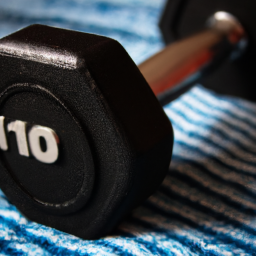
Is It Okay To Work Out When I’m Sore?
In this article, we will explore whether it is safe and beneficial to exercise when experiencing muscle soreness. You will learn about the causes of muscle soreness and how it affects your body. We will also discuss the benefits and potential risks of working out while sore, and provide helpful tips on how to approach exercising in these situations. By the end, you will have a better understanding of whether it is advisable to continue your workout routine when you are experiencing muscle soreness.
Understanding Muscle Soreness
What Causes Muscle Soreness?
Muscle soreness, also known as delayed onset muscle soreness (DOMS), is the pain and discomfort experienced after engaging in physical activity or exercise. It is commonly felt within 24 to 48 hours after a workout and is often characterized by stiffness, tenderness, and reduced range of motion in the affected muscles. While muscle soreness can be bothersome, it is a natural response of the body to the stress placed on the muscles during exercise.
The primary cause of muscle soreness is microscopic damage to the muscle fibers. When you engage in intense or unfamiliar physical activity, your muscles are forced to work harder and adapt to the increased demand. This leads to tiny tears in the muscle fibers, resulting in inflammation and soreness.
Types of Muscle Soreness
There are two main types of muscle soreness: acute muscle soreness and DOMS. Acute muscle soreness is the immediate discomfort felt during or immediately after exercise, which typically subsides within a few hours. This type of soreness is caused by the buildup of lactic acid and is a normal part of the exercise process.
On the other hand, DOMS is the soreness felt one to two days after a workout and is often more intense and longer-lasting than acute muscle soreness. DOMS occurs when the muscle fibers are subjected to excessive strain or eccentric contractions, such as during downhill running or weightlifting. The severity of DOMS varies from person to person, and it can be influenced by factors such as fitness level, age, and the intensity of the exercise.
Effects of Working Out on Sore Muscles
Benefits of Exercising When Sore
Contrary to popular belief, exercising when you’re sore can have several benefits. It can help improve blood flow to the muscles, which aids in their recovery and reduces the duration of soreness. Additionally, light exercise can assist in flushing out metabolic waste products, such as lactic acid, that contribute to muscle soreness.
Moreover, exercising when you’re sore can help improve your overall flexibility and range of motion. Gentle movements can help alleviate stiffness and reduce the chance of developing muscle imbalances, which can potentially lead to injury.
Potential Risks of Exercising When Sore
While exercising when you’re sore can be beneficial, it’s essential to listen to your body and understand when it’s appropriate to push through the discomfort and when to take a rest. Exercising with severe muscle soreness can increase the risk of further muscle damage and impede the recovery process. It’s crucial to differentiate between general muscle soreness and pain that may indicate an injury or overexertion.
Pushing through intense soreness can also negatively impact your form and technique, increasing the risk of injury. Fatigue and reduced muscle control caused by soreness can compromise your ability to perform exercises safely and effectively.
Listen to Your Body
Recognizing the Difference between Good and Bad Pain
Listening to your body is key when deciding whether to work out when you’re sore. It’s important to differentiate between good pain and bad pain. Good pain, also known as discomfort, is typically a mild to moderate soreness that you feel during or after exercise. It’s a sign that your muscles are adapting and getting stronger.
On the other hand, bad pain is more intense and localized. It may feel sharp, stabbing, or burning and could indicate an injury or overtraining. If you experience bad pain, it’s essential to rest and allow your body time to recover.
Consulting a Professional for Guidance
If you’re unsure about whether it’s safe to work out when you’re sore or if you have any underlying health conditions, it’s always a good idea to consult a healthcare professional or a certified fitness trainer. They can provide personalized advice based on your specific situation and help you develop a suitable exercise plan that considers your soreness levels and goals.
Strategies for Exercising When Sore
Rest and Recovery
Rest and recovery are crucial aspects of any fitness routine, especially when dealing with muscle soreness. Giving your body time to recover allows for proper muscle repair and adaptation. It’s important to incorporate rest days into your exercise schedule to give your muscles a chance to heal and reduce the risk of overtraining.
Additionally, incorporating active recovery activities, such as light walking or yoga, can help enhance blood flow to the muscles, promote healing, and alleviate soreness.
Light Aerobic Exercise
Engaging in light aerobic exercise can be beneficial when you’re sore. Activities such as swimming, cycling, or light jogging can help increase blood flow and promote the delivery of nutrients and oxygen to the muscles, facilitating the recovery process. Make sure to keep the intensity low and listen to your body’s signals to avoid exacerbating the soreness.
Stretching and Foam Rolling
Stretching and foam rolling can also be effective strategies for managing muscle soreness. Gentle stretching exercises can help improve flexibility and alleviate muscle tension. Foam rolling, or self-myofascial release, involves using a foam roller to apply pressure to specific areas of the body, aiding in the release of tension and promoting muscle recovery.
Alternative Activities
Low-Impact Exercises
If you’re experiencing significant muscle soreness but still want to engage in physical activity, low-impact exercises can be a suitable option. Activities such as yoga, Pilates, or tai chi provide gentle movements that help improve flexibility, strength, and balance without placing excessive strain on the muscles and joints.
Active Recovery Options
Active recovery refers to engaging in light physical activity that encourages blood flow and muscle movement without adding significant stress to the body. This can involve activities such as taking a leisurely walk, swimming, or participating in low-intensity group fitness classes. Active recovery allows you to stay active while giving your sore muscles a break from high-intensity workouts.
Preventing Muscle Soreness
Proper Warm-Up and Cool-Down
Proper warm-up and cool-down routines are essential for preventing muscle soreness. Before engaging in any physical activity, it’s crucial to warm up your muscles with dynamic stretches and light aerobic exercises. This helps increase blood flow, raises your body temperature, and prepares your muscles for the upcoming workout.
Similarly, cooling down after exercise with static stretches and light activity helps gradually bring your heart rate and body temperature back to normal and reduces the risk of post-workout muscle soreness.
Gradual Progression
Gradual progression is key when it comes to preventing muscle soreness. It’s essential to gradually increase the duration, intensity, and frequency of your workouts to give your muscles time to adapt and prevent excessive strain. Sudden increases in workout volume or intensity can lead to severe soreness and potential injury.
Hydration and Nutrition
Staying properly hydrated and fueling your body with adequate nutrition is vital for preventing muscle soreness. Dehydration can contribute to muscle cramps and increase the risk of injury, so it’s important to drink plenty of water before, during, and after exercise.
Additionally, consuming a balanced diet rich in lean proteins, healthy carbohydrates, and essential vitamins and minerals helps provide your muscles with the necessary nutrients for repair and recovery.
Recovery Techniques for After a Workout
Massage Therapy
Massage therapy can be an effective recovery technique for sore muscles. It helps increase blood flow to the muscles, reduce inflammation, and promote muscle relaxation. Different massage techniques, such as Swedish massage or deep tissue massage, can target specific muscle groups and provide relief from soreness.
Cold and Heat Therapy
Applying cold and heat therapy to sore muscles can help alleviate pain and promote healing. Cold therapy, such as ice packs or cold showers, reduces inflammation and numbs the area, providing immediate relief. Heat therapy, such as warm towels or a hot bath, helps increase blood flow, relax the muscles, and reduce muscle tightness.
Epsom Salt Baths
Taking Epsom salt baths can provide relief for sore muscles. Epsom salt, which is rich in magnesium sulfate, can help reduce inflammation, ease muscle aches, and promote relaxation. Dissolve a cup or two of Epsom salt in warm bathwater and soak for at least 15 to 20 minutes to reap the benefits.
Importance of Adequate Rest and Sleep
Muscle Repair and Growth
Adequate rest and sleep are crucial for muscle repair and growth. During sleep, the body releases growth hormones that aid in the recovery and rebuilding of damaged muscle tissue. Lack of sleep can interfere with muscle recovery, increase muscle soreness, and hinder your overall progress in achieving your fitness goals.
Benefits of Sleep for Recovery
In addition to facilitating muscle repair, sleep provides numerous other benefits for recovery. It helps regulate hormone levels, boosts the immune system, and enhances overall mental and physical well-being. Aim for 7 to 9 hours of quality sleep each night to maximize your recovery and reduce muscle soreness.
Preventing Overtraining and Injury
Balancing Intensity and Volume
Finding the right balance between workout intensity and volume is essential for preventing overtraining and injury. Pushing yourself too hard or exercising for prolonged periods without adequate rest can lead to excessive muscle soreness and increased risk of injury. It’s important to listen to your body and give yourself sufficient recovery time between intense workouts.
Listening to Your Body’s Signals
Your body provides valuable feedback that should not be ignored. Pay attention to any signs of excessive fatigue, pain, or prolonged muscle soreness that persist for an extended period. Pushing through these signals can lead to injury and setbacks in your fitness journey. Learn to respect your body’s limitations and adjust your workout intensity and volume accordingly.
Conclusion
In conclusion, working out when you’re sore can be acceptable and even beneficial under certain circumstances. Light exercise, such as walking or gentle stretching, can help reduce muscle soreness, improve flexibility, and promote recovery. However, it’s essential to listen to your body and differentiate between general muscle soreness and pain that may indicate an injury. Rest, proper nutrition, and adequate sleep are crucial for muscle repair, growth, and overall recovery. Remember to consult a professional if you’re unsure about exercising when you’re sore or if you have any underlying health conditions. By understanding your body’s signals and implementing appropriate recovery strategies, you can continue to progress towards your fitness goals while minimizing the risks associated with muscle soreness.
Easy Weight Loss With Smoothies
Read More Here:
10 Common Mistakes To Avoid When Starting A Workout Routine
7 Simple And Effective Exercises For Workout Newbies
Is It Better To Do Full-body Workouts Or Focus On Specific Muscle Groups?
